The Department of Biology and Ecology
Research Topics:
The Department explores polar biology and ecology. Our interest is focused on life surviving in extreme environments; our main areas of study are thus marine biology, terrestrial ecology, and bioprospecting, culminating in nature conservation.
In particular, our research lines are:
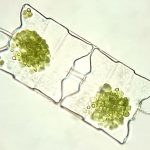
1.1. Diversity, dynamics and interaction of communities of phyto- and bacterioplankton of the maritime Antarctic during global climate changes.
Communities of marine phyto- and bacterioplankton are abundant, their genetic diversity enormous. They are the key players keeping the equilibrium between the fixation and production of CO2 and have a sizable impact on other elements’ biogeochemistry (N, S, Fe). The link connecting the bacterial and the phyto components is a fundamental research problem. Their interaction orders nutrients’ cycles and governs the productivity and endurance of sea ecosystems, as well as the carbon balance between the ocean and the atmosphere. This is felt all the stronger in the maritime Antarctic where the advancement of climate change is very apparent and disruptions in plankton productivity directly impact other sea dwellers – birds, mammals, benthos and terrestrial communities.
In 2019, the Akademik Vernadsky Station started monitoring the dynamics and interdependence of phyto- and bacterioplankton. This entails analyzing the creatures’ taxonomic and functional diversity and deciphering factors shaping their annual and seasonal dynamics, and adaptations to the antarctic conditions. The research meets SCAR priorities and lies within the AntEco, AnT-ERA and AntClimnow frameworks.
1.2. Current state and dynamics of sea mammals’ communities of the West Antarctic.
Mammals are edificators of sea ecosystems and important indicators of their state. These apex predators of the Southern ocean are a natural focal point for biological investigations in the region. In the XXth century, growing commercial whaling decimated cetaceans of the West Antarctic. Their numbers plummeted; their species composition was altered.
One of our main lines of research since 2018 has been evaluating the current state and dynamics of communities of sea mammals in the West Antarctic under the influence of the ongoing climate change. By dint of year-round observations combining photo-identification, molecular and acoustic approaches, we carry on comprehensive studies of their population structures, reproduction and feeding behaviours.
We look for regularities in the spatial distribution of mammals and birds using GIS, discovering places where they occur in large quantities and tracking their crucial developmental stages. If a dead animal is found to be autopsied, we check its tissues for stable organic pollutants.
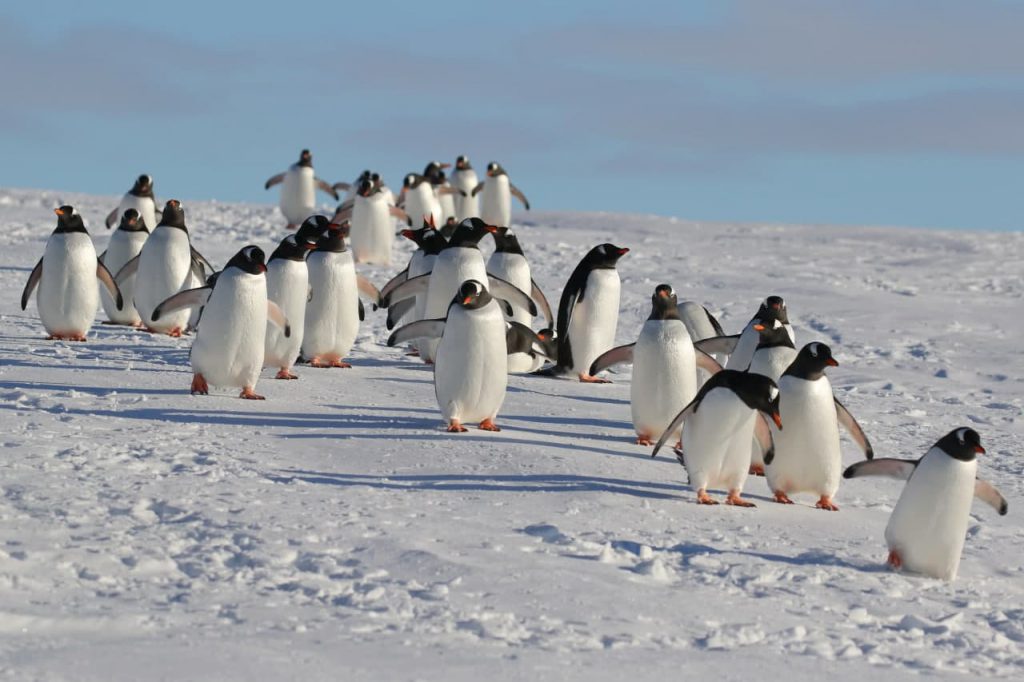
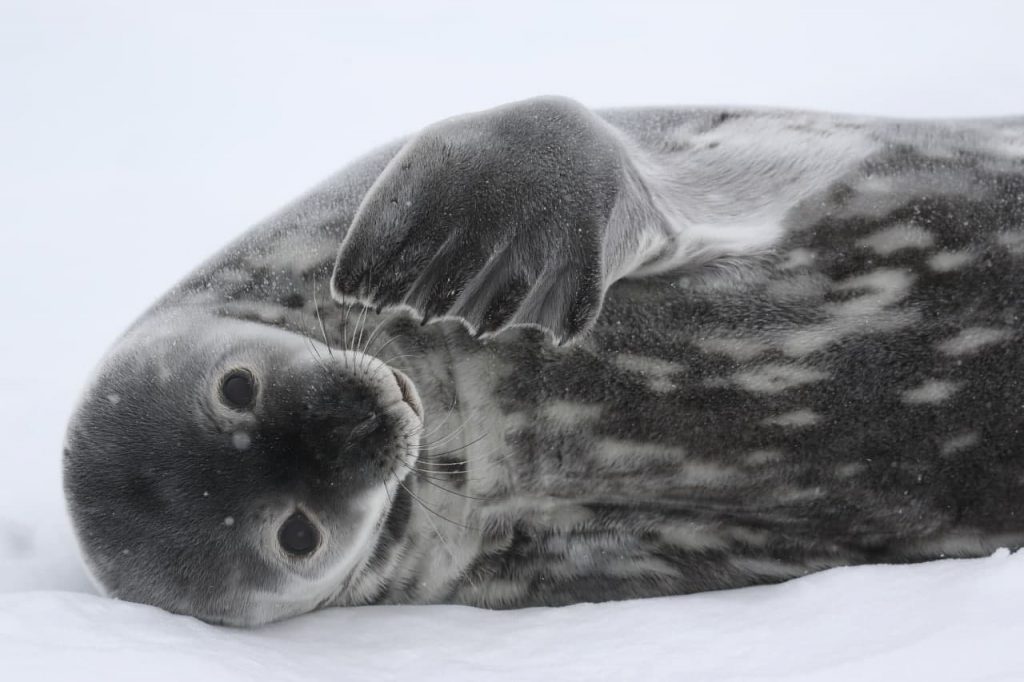
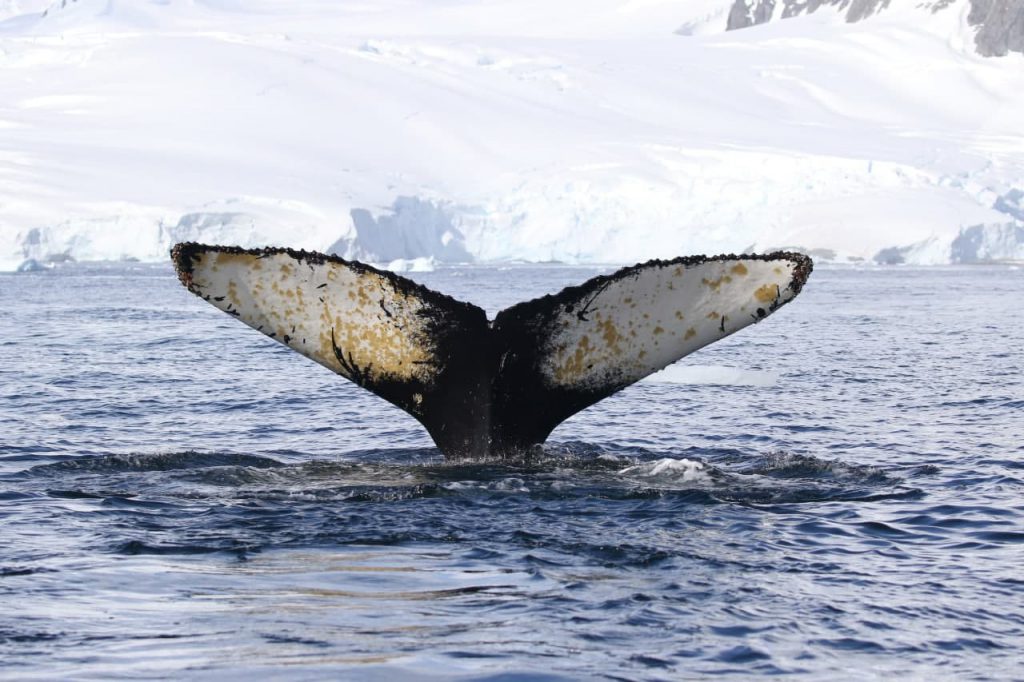
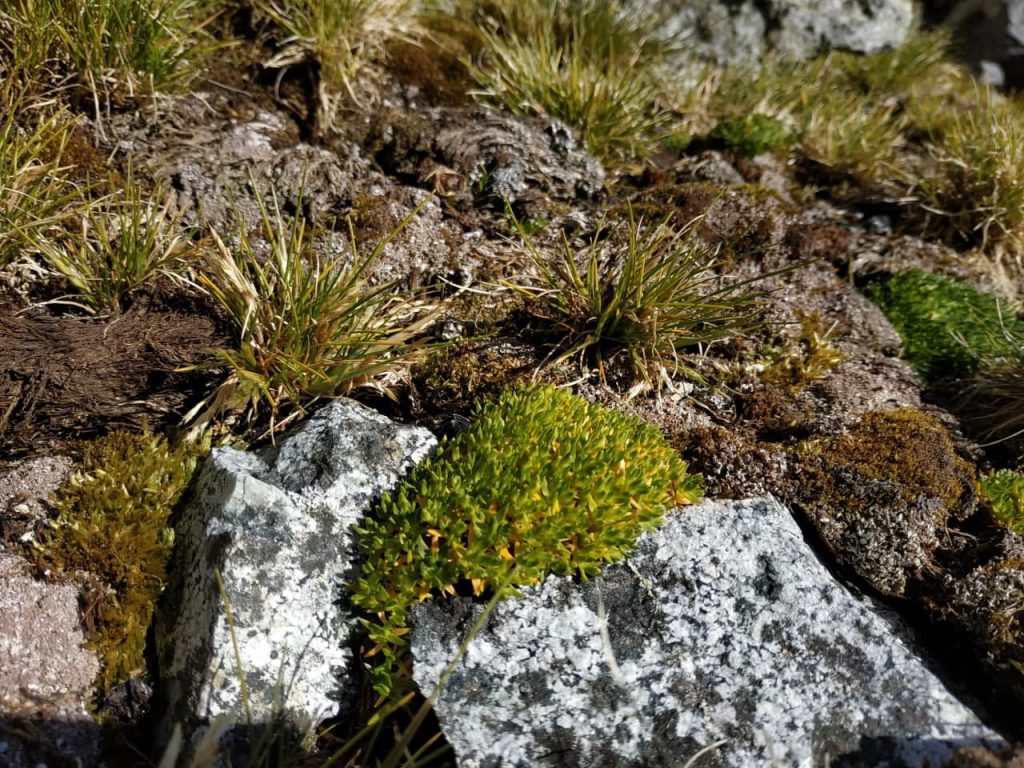
Antarctic terrestrial ecosystems exist amidst glaciers and snow. They have low biodiversity. Typically, they strongly depend on the input from prokaryotes, cryptogams and invertebrates, while the flora of vascular plants in the Antarctic numbers only two species, Deschampsia antarctica and Colobanthus quitensis. As organic matter is accumulated, habitats are created in perhaps the harshest conditions known on Earth. The Argentine Islands, where the Akademik Vernadsky Station is located, boast forty-nine species of bryophytes, seven liverworts, and 123 lichens, with algae and fungi also present. The ecosystems host some infrequent invertebrates. The whole (as well as the parts) is sensitive to climate change and to anthropogenic pressure, requiring steady monitoring and protection.
The Department’s take on the terrestrial ecosystem research includes:
- regular monitoring of the vascular plants’ populations in the Argentine Islands area. Tracking population parameters at the reference sites and surveying for new ones;
- recording the diversity of bryophytes, lichens and other ecosystem components to determine which properties of the terrestrial communities might be used to trace climate change, penguins’ impact etc.;
- investigating which microbes are associated with antarctic plants, what is their role in the plants’ adaptation to unfavourable living conditions, and how the microbiome functions reflect ornithogenic impact;
- and last but not least, unraveling the origin and current genetic heterogeneity of antarctic invertebrates: dipterans (Belgica antarctica), freshwater copepods (Boeckella poppei), springtails and tardigrades.
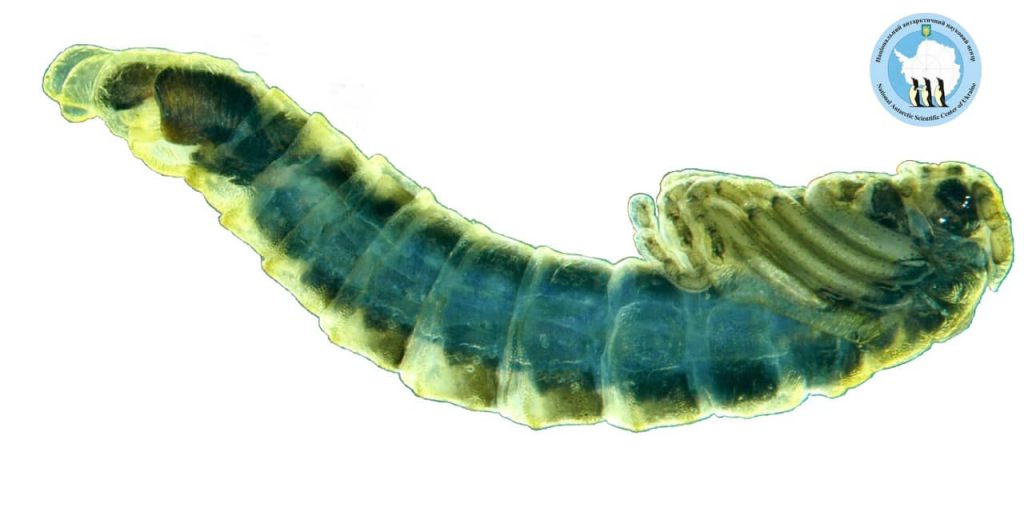
We study the diversity of microorganisms, plants and animals and their adaptations to the severe environment in the framework of programs “State of theThe Department’s take on the terrestrial ecosystem research includes: Antarctic Ecosystem” and “Antarctic Thresholds – Ecosystems Resilience and Adaptation”.
Antarctic organisms adapt to their conditions through concerted action of various systems and a whole number of BAS. That’s why the plants, animals and microbes are promising sources of valuable substances to use in biotechnology and pharmaceutics. Our research interests in particular concern the beneficial properties of the antarctic microorganisms and phenolic BAS of the plants. In order to do this we culture a collection of antarctic organisms, allowing us to not take more material from nature.
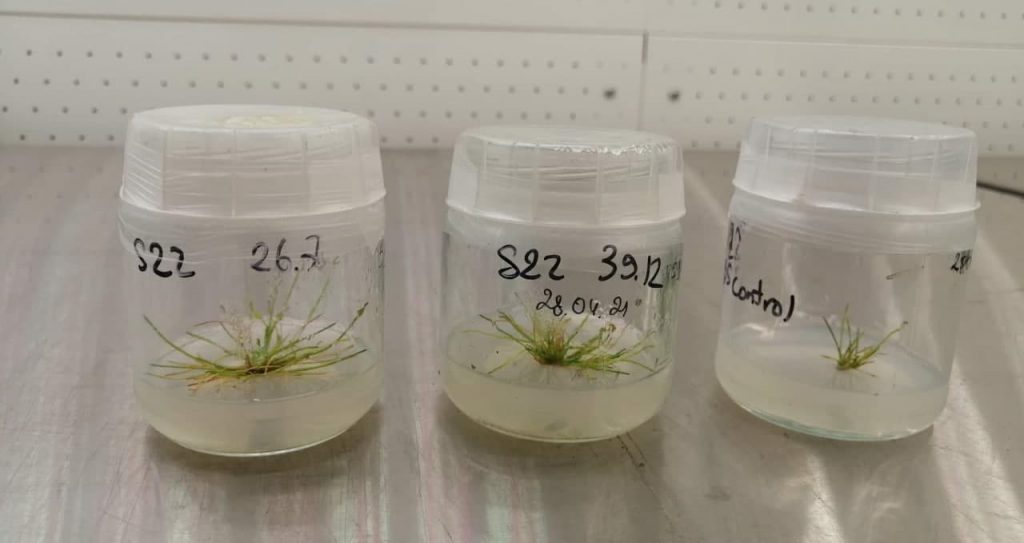
One tool to preserve unique Antarctic ecosystems is to regulate tourist flow. To do this, one has to prepare, uphold and review the guidelines on how to visit specific areas of the region, such as the Argentine Islands. We work on establishing territories with official protected status (Antarctic Specially Protected Area – ASPA).
Our interests include rare plants of the Ukrainian flora, the Black Sea inhabitants’ adjustment to global impacts, and the genetic mechanisms of adaptation to environmental conditions with Drosophila melanogaster as the model species.
You can learn more about the relevant research group here.
Our research connections
The Department partners with several scientific institutions in Ukraine: the Institute of Molecular Biology and Genetics of the National Academy of Sciences of Ukraine, Institute of Food Technology and Genomics (NASU), M. Hryshko National Botanical Garden (NASU), Taras Shevchenko National University of Kyiv, Ivan Franko National University of Lviv, etc. We also co-work with scientists and nature conservationists from Poland, Germany, the USA, Lithuania, Belarus, Turkey, Malaysia, Slovakia, Czechia, and other countries.
Publications
Pavlovska, M., Prekrasna, I., Dykyi, E., Zotov, A., Dzhulai, A., Frolova, A., Slobodnik, J. & Stoica, E. (2021). Niche partitioning of bacterial communities along the stratified water column in the Black Sea. MicrobiologyOpen, 10(3), e1195. https://doi.org/10.1002/mbo3.1195
Pavlovska M, Prekrasna I, Parnikoza I, Dykyi E. Soil Sample Preservation Strategy Affects the Microbial Community Structure. Microbes and Environments, 36(1), ME20134. https://doi.org/10.1264/jsme2.ME20134
Podolich, O., Prekrasna, Ie., Parnikoza, I., Voznyuk, T., Zubova, G., Zaets, I., Miryuta, N., Myryuta, G., Poronnik, O., Kozeretska, I., Kunakh, V., Pirttila, A.M., Dykyi, E., & Kozyrovska, N. (2021). First record of the endophytic bacteria of Deschampsia antarctica Ė. Desv. from two distant localities of the maritime Antarctic. Czech Polar Reports, 11(1), 134-153. https://doi.org/10.5817/CPR2021-1-10
Michailova, P., Ilkova, J., Kovalenko, P., Dzhulai, A., Kozeretska, I. (2021) Long-term retainment of some chromosomal inversions in a local population of Belgica antarctica Jacobs (Diptera, Chironomidae). Czech Polar Reports, 11(1), 16-24. https://doi.org/10.5817/CPR2021-1-3
Kozeretska, I., Serga, S., Kovalenko, P., Gorobchyshyn, V., Convey, P. (2021). Belgica antarctica (Diptera: Chironomidae): A natural model organism for extreme environments. Insect Science, 0, 1-19. https://doi.org/10.1111/1744-7917.12925
Michailova, P., Ilkova, J., Kovalenko, P.A., Gorobchyshyn, V.A., Kozeretska, I.A., Convey, P. (2021). External Morphology of Larvae of Belgica antarctica Jacobs, 1900 (Diptera, Chironomidae) Obtained from Two Locations in Maritime Antarctica. Insects, 12(9), 792. https://doi.org/10.3390/insects12090792
Mioduchowska, M., Kačarević, U., Miamin, V., Giginiak, Y., Parnikoza, I., Roszkowska, M. & Kaczmarek, Ł. (2021). Redescription of Antarctic eutardigrade Dastychius improvisus (Dastych, 1984) and some remarks on phylogenetic relationships within Isohypsibioidea. European Zoological Journal, 88(1), 117-131. https://doi.org/10.1080/24750263.2020.1854877
Zawierucha, K., Porazinska, D.L., Ficetola G.F., Ambrosini, R., Baccolo, G., Buda, J., Ceballos, J.L., Devetter, M., Dial, R., Franzetti, A., Fuglewicz, U., Gielly, L., Łokas, E., Janko, K., Novotna Jaromerska, T., Koscinski, A., Kozłowska, A., Ono, M., Parnikoza, I., Pittino, F., Poniecka, E., Sommers, P., Schmidt, S.K., Shain, D., Sikorska, S., Uetake, J., & Takeuchi, N. (2020). A hole in the nematosphere: tardigrades and rotifers dominate the cryoconite hole environment, whereas nematodes are missing. Journal of Zoology, 1, 18-36. https://doi.org/10.1111/jzo.12832
Kondratyuk, S.Y., Lokös, L., Oh, S.-O., Kondratyuk, T.O., Parnikoza, I.Yu., & Hur, J.-S. (2020). New and noteworthy lichen-forming and lichenicolous fungi, 11. Acta Botanica Hungarica, 62(3–4), 225–291. https://doi.org/10.1556/034.62.2020.3-4.3
Козерецька І.А., Корсун С.Г., Парнікоза І.Ю. / Kozeretska I., Korsun S., Parnikoza I. Патент на корисну модель №139545: Спосіб визначення фонового вмісту важких металів у ґрунтах островів Морської Антарктики / Utility model patent №139545: Method for determining the background content of trace elements in the soils of the islands of the maritime Antarctic. Зареєстровано в Державному реєстрі патентів України на корисні моделі 10.01.2020 р.
Gora, N.V., Serga, S.V., Maistrenko, O.M., Ślęzak-Parnikoza, A., Parnikoza I.Yu., Tarasiuk, A.N., Demydov, S.V., & Kozeretska, I.A. (2020). Climate Factors and Wolbachia Infection Frequencies in Natural Populations of Drosophila melanogaster. Cytology and Genetics, 54(3), 189-198. https://cytgen.com/en/2020/_16-27N3V54.htm (in Ukrainian)
Nuzhyna, N., Parnikoza, I., Poronnik, O., Kozeretska, I., & Kunakh, V. (2019). Anatomical variations of Deschampsia antarctica É. Desv. plants from distant Antarctic regions, in vitro culture, and in relations to Deschampsia caespitosa (L.) P. Beauv. Polish Polar Research, 40(4), 361–383. https://doi.org/10.24425/ppr.2019.130903
Parnikoza, I. Yu., & Kozeretska, I. (2019). Antarctic Terrestrial Biome — Most Poor, Extreme and Sensitive on the Planet. In M. I. Goldstein, & D. A. DellaSala (Eds.), Encyclopedia of biomes, 2 (pp. 606-622). Elsevier. https://doi.org/10.1016/B978-0-12-409548-9.12005-6
Miryuta, N.Yu., Smykla, J., Parnikoza, I.Yu. (2019). Algorithm for the United Quality Latent Index of the plant adaptability and its application field in monitoring of Deschampsia antarctica È. Desv. populations. Ukrainian Antarctic Journal, 1(18), 152-168. http://uaj.uac.gov.ua/index.php/uaj/article/view/139/87
Tistechok, S., Skvortsova, M., Luzhetskyy, A., Fedorenko, V., Parnikoza, I., & Gromyko, O. (2019). Antagonistic and Plant Growth Promoting Properties of Actinomycetes from Rhizosphere Deschampsia antarctica É. Desv. (Galindez Island, Antarctica). Ukrainian Antarctic Journal, 1(18), 169—177. http://uaj.uac.gov.ua/index.php/uaj/article/view/140/88
Parnikoza, I.Yu., Miryuta, N.Yu., Ivanets, V.Yu., & Dykyi E.O. (2019). Determination of the united quality latent index of adaptability (UQLIA) and contribution of some environmental parameters to it for Deschampsia antarctica populations, Galindez Island (maritime Antarctic) season 2017/2018. The Bulletin of Ukrainian Society of Gentetics and Breeders, 16(2), 190-202. https://doi.org/10.7124/visnyk.utgis.16.2.1057 (in Ukrainian)
Roszkowska, M., Grobys, D., Bartylak, T., Gawlak, M., Kmita, H., Kepel, A., Kepel, M., Parnikoza, I. & Kaczmarek, Ł. (2020). Integrative description of five Pseudechiniscus species (Heterotardigrada: Echiniscidae: the suillus-facettalis complex). Zootaxa, 4763(4), 451–484. https://doi.org/10.11646/zootaxa.4763.4.1
Kaczmarek, Ł., Mioduchowska, M., Kačarević, U., Kubska, K., Parnikoza, I., Gołdyn, B., & Roszkowska, M. (2020). New Records of Antarctic Tardigrada with Comments on Interpopulation Variability of the Paramacrobiotus fairbanksi Schill, Förster, Dandekar and Wolf, 2010. Diversity, 12(3), 108. https://doi.org/10.3390/d12030108
Ellis, L.T., Afonina, O.M., Czernyadjeva, I.V., Konoreva, L.A., Potemkin, A.D., Kotkova, V.M., Alataş, M., Blom, H.H., Boiko, M., Cabral, R.A., Jimenez, S., Dagnino, D., Turcato, C., Minuto, L., Erzberger, P., Ezer, T., Galanina, O.V., Hodgetts, N., Ignatov, M.S., … Graulich A. (2020). New national and regional bryophyte records, 63. Journal of Bryology, 42(3). https://doi.org/10.1080/03736687.2020.1750930
Kondratiuk, T.O., Beregova, T.V., Parnikoza, I.Yu., Kondratyuk, S.Y. & Thell, A. (2020). Microscopic fungi of lithobiont communities of Argentine Islands region: data from the 22nd Ukrainian Antarctic Expedition. Acta Botanica Hungarica, 62(1–2), 49–68. https://doi.org/10.1556/034.62.2020.1-2.5
Bublyk, O., Andreev, I., Parnikoza, I., & Kunakh, V. (2020). Population genetic structure of Iris pumila L. in Ukraine: effects of habitat fragmentation. Acta Biologica Cracoviensia Series Botanica, 62(1), 51–61. https://doi.org/10.24425/abcsb.2020.131665
Bedernichek, T., Loya, V., & Parnikoza, I. (2020). Content of biogenic and toxic elements in the leaves of Deschampsia antarctica É. Desv. (Poaceae): a preliminary study. Plant Introduction, 85/86, 124-129. https://doi.org/10.46341/PI2020017
Parnikoza, I., Berezkina, А., Moiseyenko, Y., Malanchuk, V., & Kunakh, V. (2018). Complex survey of the Argentine Islands and Galindez Island (maritime Antarctic) as a research area for studying the dynamics of terrestrial vegetation. Ukrainian Antarctic Journal, 1(17), 73-101. (in Ukrainian) http://uaj.uac.gov.ua/index.php/uaj/article/view/34 (in Ukrainian)
Scientific projects
- (together with the Max Planck Institute for Marine Microbiology, Germany) Exploring the interplay of Antarctic bacterioplankton and phytoplankton by integration of biodiversity, contextual, and OMICS data;
- (together with the University of Oulu, Finland) Exploring beneficial role of endophytic bacteria for survival of Deschampsia antarctica in arid Antarctic environments using culture based and OMICS-techniques;
- Studying a sub-population of sub-Antarctic penguins using a system of remote cameras according to CEMP protocols;
- (in partnership with our colleagues from Belarus) Terrestrial ecosystems under the influence of global changes in two different climatic zones of Antarctica.


